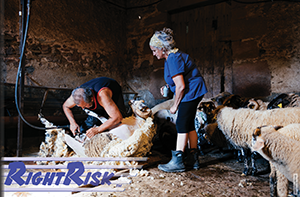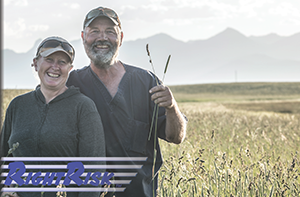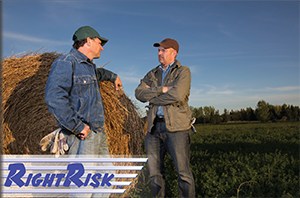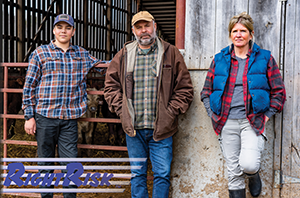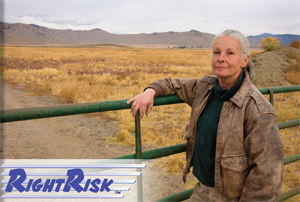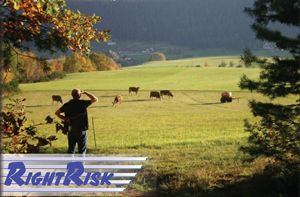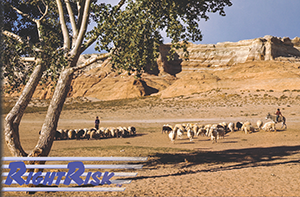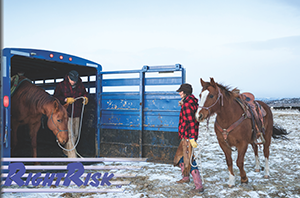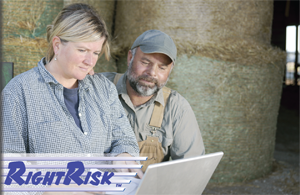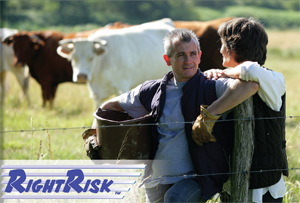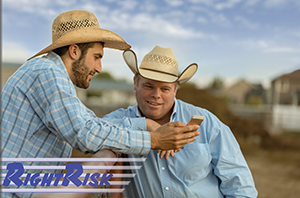 | |
Risk Management Profiles |
|
|
Beginning Farmers Learn about Farm Records |
Managing Precipitation Risk |
|
|
|
Beginning Farmers Learn about Farm Records
Jack and Diane live on a larger property that the previous owner had used to grow hay and raise livestock. Upon his retirement two years ago, Jack purchased several ewes and the equipment necessary to harvest the hay. He sells the lambs and any leftover hay. Diane is a teacher who loves to spend her summers in their large garden. She generates a few extra dollars by selling some of the vegetables at the local farmersí market. Jack and Diane were confused as they drove home from a meeting with a tax preparer. They had always filed their own tax returns. However, this year they thought it would be best to get some outside advice since they had received lots of money by selling more lambs and hay than normal. They didnít know they were farmers. |
|
|
|
|
Benchmarking in Agriculture
Paul was home from college on break and was talking to his parents about a class he had just completed. He told his parents that he learned about a powerful management tool called benchmarking that is becoming popular for agricultural producers to use. Jack, Paul?s dad, said that he had just read about benchmarks in a recent farm magazine. The magazine article compared benchmarks in agriculture to going to a doctor?s office for a checkup. |
|
|
|
|
Big Country Farms ponders
risk management strategies Big Country Farms, operated by John and Jen Colpher, is a dryland wheat farm with some irrigated wheat and dryland sunflower acreage. Hail and drought are the couple's primary risk management concerns, but they are also concerned with volatile commodity markets. Although they have experienced severe drought on and off for eight years, it is just now beginning to affect irrigation water. The risks associated with large swings in wheat prices have also created increased anxiety regarding their current level of risk protection. |
|
|
|
|
Big Horn County sugar beet growers look
to manage production risk Big Horn County farmers Ken and Rich Riff own Riff Brothers Farms -- 600 acres of dry beans, sugar beets, and barley (usually 200 acres of each). They are particularly worried about production risk with their sugar beet acres this spring. Last fall and winter were extremely dry with mild temperatures, so the brothers know that soil moisture is low. Their beets may require irrigation to germinate or they may need replanting. |
|
|
|
|
Cody and Janet Explore LRP Insurance Cody and Janet Rhodes raise hay and barley on a farm near Fairbanks Alaska, while also running about 100 head of beef cows. Steer calves are raised to a slaughter weight of about 1,200 pounds and sold directly into the local market for consumption. Janet and Cody have noticed quite a bit of volatility in the price received for the animals from year-to-year compared to the relatively stable price the loyal friends and family are willing to pay to buy their beef year in and year out. Once in a while, they need to utilize online bidding tools to make sure they receive a fair market price. |
|
|
|
|
Exploring Insurance Options for An Expanding Specialty Crop Business Tom and Chris Lin have been involved in agriculture for eight years. Shortly after moving to a small acreage outside of Anchorage, they started growing vegetables for sale at a roadside stand. Soon, they expanded production enough to start selling at a local farmers market and built a greenhouse to facilitate year-round production. Understanding the importance of diversification, they expanded into the cut flower business and built up several wholesale customers in addition to their retail business. |
|
|
|
|
|
Exploring Farm
Revenue Protection Options Alaskans Tim and Kathy Dworak have been heavily invested in the peony business for the last six years. Recently, they began to explore what risk management tools might be available as they think about their plans for expanding the operation. |
|
|
|
|
|
Farm Family Confronts
Financial Distress Head-on Brent and Jenny are in their mid-60s and have a farm in Alaska. Over their almost 40 years of marriage, Brent and Jenny have been able to live comfortably on profits from the farm. When they recently shared copies of their balance sheet, both sons and their wives were surprised. |
|
|
|
|
|
Feasibility of Alternative Enterprises On a cold January evening Raymond and his son Larry were sitting around the kitchen table to begin their monthly management meeting. The primary purpose of this month’s meeting was to further discuss the possibility of adding alternative enterprises to their operation to help diversify income streams on the ranch. |
|
|
|
|
|
Fillizar Ranches Manage
Forage and Marketing Risks Art Fillizar and his wife Leinani Aku own and operate Fillizar Ranches on one of the islands of Hawaii. Art grew up on the ranch that has been in the family for several generations. They have always been a cow-calf operation, marketing their beef mostly through local markets. |
|
|
|
|
Flora, Alvin and Chris Consider
A Risk Influence Calculator Alvin Doddy raises hay, cattle and corn on a farm in eastern Wyoming with his wife Flora and their teenage son Chris. Like all farm families, the Doddys face a multitude of risks including production, market, and financial risks. However, institutional risk brought about by changes in government programs, import/export policies, and environmental rules and regulations have taken more time to manage lately. |
|
|
|
|
|
Gates Creek Land and Livestock compares risk
management options for hay and forages Platte County producers John and Marcia Smith own Gates Creek Land and Livestock, a 100-head commercial cow herd operation with 250 irrigated acres. The Smiths primarily use the irrigated acreage to provide feed for their cow-calf enterprise with 150 acres of alfalfa and 100 acres in corn for both grain and silage. Recent high hay prices have the Smiths considering cutting the corn acreage to 50 acres for silage and seeding the other 50 acres to alfalfa. Due to rising input prices, the Smiths are concerned their bottom line is not well-protected against the unexpected. |
|
|
|
|
|
Insurance options help Bell Livestock
manage price risk Carbon County's Bell Livestock runs 300 cow-calf pairs and, for the last four years, has retained ownership of its steer calves. Owners Norm and Belinda Bell plan to do the same this year with their 155 steers at a central Nebraska feedlot. Because of the southern drought, the Bells are concerned that volatility in fat cattle and feed prices may affect profitability. |
|
|
|
|
Keeping Records on Your Farm or Ranch Juan and Suzanne were sitting in their kitchen one January afternoon getting information ready to take to their tax preparer. Check stubs, invoices, receipts, weigh tags from the local co-op, and sale bills were scattered across the table. Suzanne was frustrated with the mess and with the amount of information Juan kept in his head. They both knew they would have a better handle on their finances, keep their banker happier, and be better prepared for their tax preparer if they maintained good financial records throughout the year. They just did not know where to begin. |
|
|
|
|
Lasting Legacy Bill and Jean Parnel recently graduated from college. They are a young married couple with plans to take over the Parnel Family Farm. They would be the fourth generation to own and manage the farm. |
|
|
|
|
LRP Feeder Cattle Late summer 2011, John and Polly Harkin were preparing for another fall calving sea-son on their Virginia farm. They were concerned about their costs of production and the perceived risk they were seeing in the marketplace. |
|
|
|
|
|
Managing Precipitation Risk
on New Mexico Rangelands Tim and Tina are a married couple operating a small ranch in northwestern New Mexico. They raise sheep and lambs on a 2,400-acre range unit shared among three family members. When drought occurs, sheep prices are usually low and hay prices are usually high. This leaves them with a difficult financial decision to make. |
|
|
|
|
Managing price risk
on the Z-F Ranch Nestled in the heart of Fremont County, the Z-F Ranch runs 300 pairs and 150 yearling steers. From these numbers, owners Bob and Betsy Zomer typically sell 100 head of 500-pound heifer calves and 150 head of 900-pound yearling steers every fall. Although pleased with last year's near record prices, the Zomers wanted to ensure or lock-in the record cattle prices this year. |
|
|
|
|
Morgan Family: A Successful Transition Plan Ted and Sally Morgan owned and operated a small beef operation for the last 40 years. The ranch consists of 200 beef cows, 40 acres of hay, and some pasture land. The Morganís sell their calves through the local sale barn. Due to increasing expenses, the cowcalf enterprise has not been very profitable in recent years. The lack of profit has prevented Ted and Sally from saving much money for retirement. |
|
|
|
|
On Solid Ground:
Insuring Whole Farm Success Dan and Kate Leader moved to the Anchorage, Alaska area four years ago. Soon after moving to the area, Dan and Kate were able to locate and purchase property outside of Anchorage. In just three years, they have managed to put enough money away that they are starting to seriously discuss plans to remodel the farm house into their dream home. Kate poured herself a cup of coffee and sat down at the kitchen table with Dan one morning and asked him how comfortable he would be taking out a loan to speed up the process a bit and make it happen within the next year. |
|
|
|
|
|
Planning for the Passing:
Carl and Cathy Call for a Family Meeting Carl and Cathy live on the ranch they inherited from Cathyís mother. They run 25 beef cows and 50 ewes and sell about 100 tons of hay. Carl also has a job in town. They have three adult children and six grandchildren. Since the adult children were coming home for Thanksgiving, Cathy asked them to come two days early. She and Carl wanted to have a family meeting to discuss their legacies, who might be interested in taking over the ranch, and who might want certain personal possessions. |
|
|
|
|
Rainfall Index-PRF helps manage
drought risk for Hagland Farms Early fall 2011 on the Hagland Farms found owners Jim and Carol Hagland looking at several risk management strategies for their cattle operation. Jim and Carol were both concerned about the coming production year. Late summer and early fall weather had been very dry and they were worried it would carry over into next year. The Haglands are considering several options for addressing production risk. |
|
|
|
|
|
RI-PRF pilot insurance
minimizes feed risk for Z-F Early fall on the Z-F Ranch found owners Bob and Betsy Zomer assessing risk management strategies for their cow-calf and yearling operation. The Zomers are situated on 12,000 acres of pasture and 200 acres of native hay in Fremont County. Both husband and wife were concerned about the coming production year. This year's late summer and early fall had been dry, and they were worried it would carry over into next year. |
|
|
|
|
Riff Brothers Farms minimizes financial
loss with multi-peril crop insurance Big Horn County farmers Ken and Rich Riff of Riff Brothers Farms manage 600 acres of dry beans, sugar beets, and barley. Commodity prices are high, and the coming production season has the potential for those prices to hold into the fall. Input prices are at or near historical highs and the Riffs are looking to guarantee a certain revenue level to protect their bottom line. Big Horn County is recovering from a recent drought, and the Riffs are concerned severe weather may return. |
|
|
|
|
Risk Management Strategies for
Specialty Crop Producers in Alaska Barb and Sue are partners in a flower and vegetable business near Homer, Alaska. Barb recently attended several workshops and webinars looking at identifying and managing the risks associated with their specialty crop business. During one of their regular management meetings, Barb suggested that they take some time to discuss risk management in their business. |
|
|
|
|
Exploring Risk Management
Tools Available at RightRisk.org Chase Law has been farming and ranching with his dad for the past seven years in northern Wyoming. Since he returned to the ranch, they have expanded the operation by adding about 160 acres of hay ground and 250 head of cows with an accompanying array of BLM and U.S. Forest Service permits. Chase has been thinking a lot lately about their increasing exposure to risk. In particular, potential downturns in the cattle market, extreme weather events like blizzards and droughts, and the mounting challenges of relying on multi-use public lands for a majority of their grazing resources have kept him up late at night researching information on the internet. |
|
|
|
|
|
Six-Step Process for Managing Risk: A New Mexico Scenario Tate and Shyann are a married couple operating a farm in northwestern New Mexico. They raise sheep/lambs and alfalfa hay... Every year drought is a major risk that threatens their opportunity to generate profits on their farm, and last year a major drought negatively impacted the forage production of their grazing lands and the yields of their hay lands to a point it nearly put them out of business. |
|
|
|
|
|
Sources of Risk and
Personal Risk Preferences Rich and Sally Samedi have been farming in Alaska for close to 20 years. During that time they have encountered a variety of different risks. Sometimes things have worked out well; sometimes not so well. |
|
|
|
|
Three Ladies, LLC
Managing Income Tax Liabilities Vanessa, Bonnie, and Sally are partners in a small farm. They raise vegetables, potatoes, and peonies for sale at the farmer markets in Anchorage. They attended a RightRisk training last winter where the two speakers addressed a number of risk management topics. They learned about several management strategies of which one pertained to managing one's income taxes with the speaker sharing a few key points. |
|
|
|
|
Triple Creek Ranch: Strategic
Growth into Direct Meat Marketing Mark and Sarah Peterson didnít start Triple Creek Ranch with the intention of becoming a significant player in Alaskaís local beef market. They purchased their 200-acre property outside Palmer, Alaska, starting with just 10 head of Shorthorn-Hereford cross cattle. Through careful management and strategic reinvestment, theyíve grown to their current 30-head operation, finishing all their cattle for Regional Prime Processing. |
|
|
|
|
| Send
comments or questions to information@rightrisk.org Copyright © 2002 RightRisk All Rights Reserved. |
|
